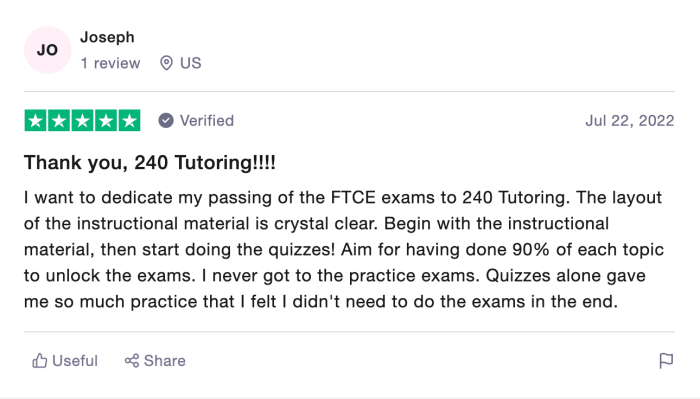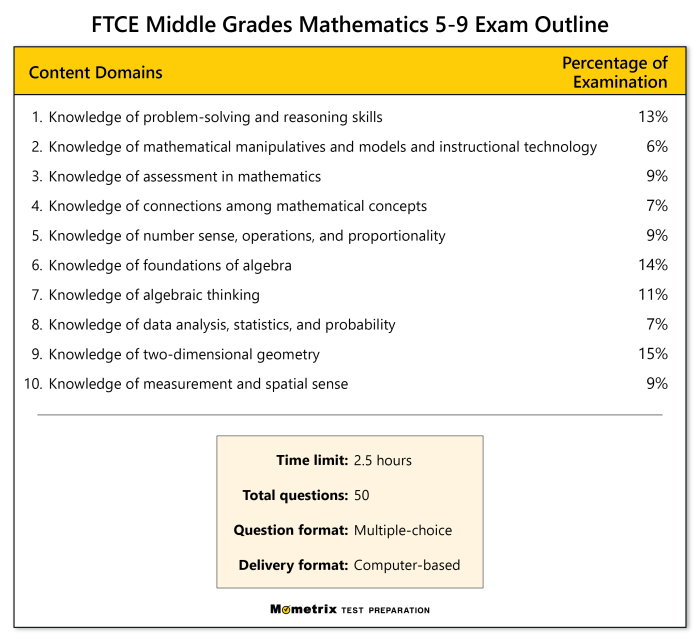Ftce math 5-9 practice test free – Kick-starting your journey towards FTCE Math 5-9 exam success, our free practice test offers an unparalleled opportunity to refine your mathematical prowess. Dive into this comprehensive guide and unveil the secrets to conquering the actual exam with confidence.
Delving into the intricacies of the FTCE Math 5-9 practice test, this guide unveils its purpose, structure, content coverage, question types, and effective test-taking strategies. Harnessing this knowledge, you will embark on a transformative journey, identifying areas for improvement and maximizing your potential for exam success.
FTCE Math 5-9 Practice Test Overview
The FTCE Math 5-9 practice test is a valuable tool for educators seeking certification in the state of Florida. It provides a comprehensive overview of the content and format of the actual exam, enabling candidates to identify areas of strength and weakness.The
practice test consists of 150 multiple-choice questions, mirroring the actual exam. Candidates are given 3 hours and 30 minutes to complete the test. The questions are divided into five subtests: Number Sense, Concepts, and Operations; Measurement; Geometry and Spatial Sense; Data Analysis and Probability; and Algebra.
Each subtest is weighted differently, with Number Sense, Concepts, and Operations carrying the highest weight.The scoring system for the practice test is designed to provide candidates with a realistic assessment of their performance. The questions are scored based on the same criteria as the actual exam, and candidates receive a scaled score ranging from 100 to 300. A passing score of 200 is required for certification.
Content Coverage of the Practice Test

The FTCE Math 5-9 Practice Test comprehensively assesses a wide range of mathematical concepts and skills that are essential for success in teaching mathematics at the middle school level.
The test content is organized into four primary subcategories: number sense, algebra, geometry, and measurement.
Number Sense
- Understanding and applying number systems (e.g., whole numbers, decimals, fractions)
- Performing operations on numbers (e.g., addition, subtraction, multiplication, division)
- Estimating and approximating numbers
- Understanding number relationships (e.g., place value, order of operations)
Algebra
- Solving equations and inequalities
- Understanding and applying algebraic expressions
- Graphing linear equations
- Solving systems of equations
Geometry
- Understanding and applying geometric shapes (e.g., triangles, circles, polygons)
- Measuring and calculating geometric properties (e.g., area, perimeter, volume)
- Understanding and applying geometric transformations (e.g., rotations, translations)
- Solving geometric problems
Measurement
- Understanding and applying measurement systems (e.g., customary, metric)
- Measuring and calculating length, area, volume, and weight
- Converting between measurement units
- Solving measurement problems
Question Types and Formats: Ftce Math 5-9 Practice Test Free

The FTCE Math 5-9 Practice Test comprises multiple question types, each designed to assess specific skills and knowledge.
These question types include:
Multiple Choice, Ftce math 5-9 practice test free
Multiple-choice questions present several answer options, with only one correct response. These questions test your ability to identify the correct answer among distractors.
Example:
Which of the following is the least common multiple of 6 and 10?
- 12
- 20
- 30
- 60
Approach:
- Calculate the least common multiple (LCM) of 6 and 10.
- Compare the calculated LCM with the answer options to identify the least value.
Short Answer
Short-answer questions require you to provide a concise, written response, usually a number, a word, or a short phrase. These questions test your ability to apply concepts and solve problems.
Example:
Find the area of a rectangle with a length of 5 cm and a width of 3 cm.
Approach:
- Recall the formula for the area of a rectangle: A = l × w.
- Substitute the given values and calculate the area.
Constructed Response
Constructed-response questions are extended, open-ended questions that require you to demonstrate your understanding of concepts and problem-solving abilities.
Example:
Explain the steps involved in solving the following equation: 3x + 5 = 14.
Approach:
- List the steps involved in solving the equation, including isolating the variable.
- Show your work and provide clear explanations.
Strategies for Taking the Practice Test

To enhance your preparation for the FTCE Math 5-9 exam, it is crucial to approach the practice test strategically. Effective time management, thoughtful question selection, and efficient problem-solving techniques can significantly impact your performance.
Time Management
- Distribute the allocated time wisely across different sections and questions. Prioritize questions that carry more weightage.
- Allocate specific time slots for each question, allowing ample time for reading, comprehension, and calculation.
- Manage time effectively by skipping challenging questions initially and returning to them later if time permits.
Question Selection
Strategically selecting questions can maximize your score potential.
- Begin with questions that you are confident in, building momentum and reducing anxiety.
- Identify questions that align with your strengths and focus on answering them correctly.
- Mark challenging questions for later review, ensuring you allocate time for them if possible.
Problem-Solving Techniques
Effective problem-solving techniques can help you navigate complex questions efficiently.
- Read questions carefully, ensuring comprehension before attempting to solve them.
- Break down complex problems into smaller, manageable steps.
- Utilize diagrams, tables, or other visual aids to organize information and clarify concepts.
- Estimate answers when exact solutions are not readily apparent.
- Check your work by reviewing answers and identifying any errors.
Analyzing Results and Identifying Areas for Improvement
After completing the FTCE Math 5-9 practice test, it is crucial to analyze the results thoroughly to identify areas of strength and weakness. This analysis will provide valuable insights into the specific areas that require further attention and improvement.
Developing a Plan for Improvement
Based on the analysis of the practice test results, it is essential to develop a comprehensive plan for improvement. This plan should include:
- Reviewing concepts:Identify the specific concepts and skills where weaknesses were identified. Focus on reviewing these concepts thoroughly using textbooks, online resources, or tutoring sessions.
- Practice problems:Engage in ample practice by solving additional problems related to the areas of weakness. This will reinforce understanding and improve problem-solving abilities.
- Time management:Analyze the time spent on each section of the practice test. Identify areas where time management was inefficient and develop strategies to improve pacing during the actual exam.
- Test-taking strategies:Reflect on the test-taking strategies used during the practice test. Evaluate their effectiveness and identify areas where improvements can be made, such as managing anxiety or utilizing effective time management techniques.
- Seek support:Consider seeking support from teachers, tutors, or study groups to address specific areas of difficulty and enhance understanding.
Benefits of Using the Practice Test
Engaging in the FTCE Math 5-9 practice test offers several advantages that can enhance your preparation for the actual exam. These include:
Familiarization with the Test Format
The practice test provides an invaluable opportunity to familiarize yourself with the structure, format, and question types that you can expect on the actual FTCE Math 5-9 exam. This familiarity reduces surprises and anxiety on test day, allowing you to allocate your time and effort more effectively.
Improved Confidence
Completing the practice test can significantly boost your confidence in your abilities. By experiencing the test format and question types firsthand, you gain a better understanding of the material covered and your strengths and weaknesses. This enhanced confidence translates into improved performance on the actual exam.
Reduced Anxiety
Taking the practice test under timed conditions simulates the real exam experience and helps you develop coping mechanisms for test-related anxiety. By practicing in a controlled environment, you can identify areas where you need to improve your time management and reduce anxiety levels, resulting in a more relaxed and focused approach on test day.
Success Stories
Numerous individuals have attested to the benefits of utilizing the FTCE Math 5-9 practice test. Here are a few testimonials:
“The practice test gave me a clear understanding of the exam format and question types. I felt much more confident going into the actual exam, and it ultimately helped me pass.”- Sarah J.
“I was initially nervous about the FTCE Math 5-9 exam, but the practice test helped me identify my strengths and weaknesses. By focusing on the areas where I needed improvement, I was able to significantly increase my score.” – John D.
Essential FAQs
What is the purpose of the FTCE Math 5-9 practice test?
The FTCE Math 5-9 practice test serves as a diagnostic tool, providing insights into your strengths and weaknesses, and enabling you to tailor your preparation accordingly.
How many questions are on the FTCE Math 5-9 practice test?
The FTCE Math 5-9 practice test comprises a comprehensive set of questions, mirroring the actual exam’s content and difficulty level.
What is the time limit for the FTCE Math 5-9 practice test?
The FTCE Math 5-9 practice test adheres to the same time constraints as the actual exam, ensuring an authentic test-taking experience.